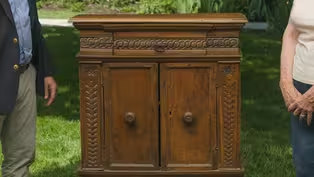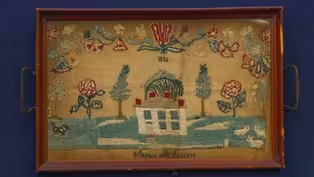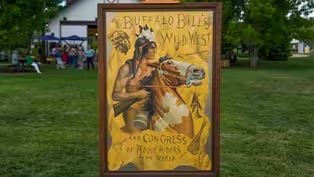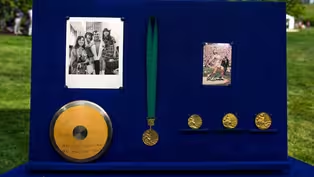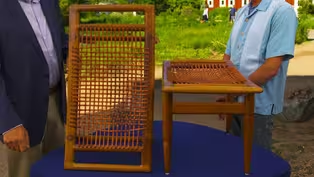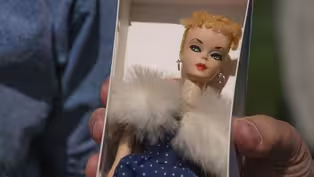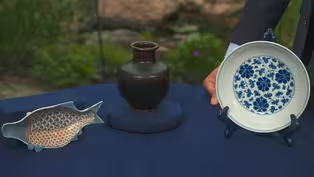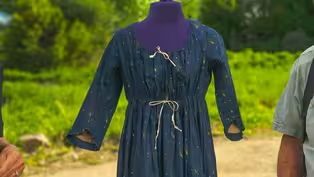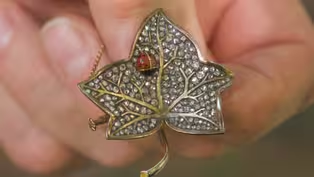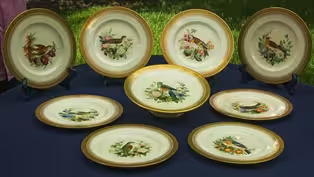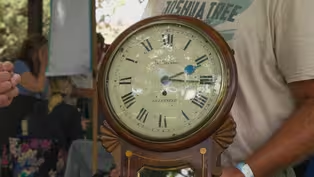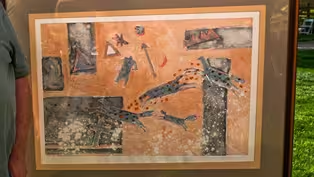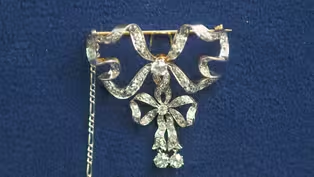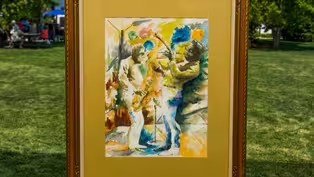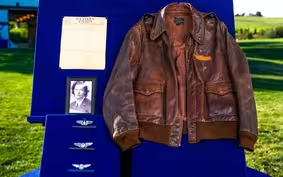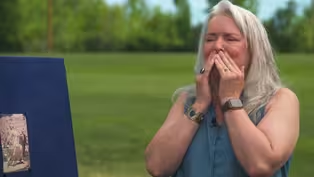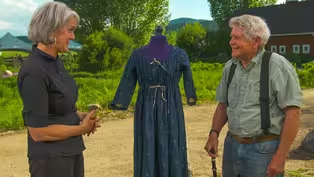
Denver Botanic Gardens Chatfield Farms, Hour 3
Season 29 Episode 12 | 52m 26sVideo has Closed Captions
ROADSHOW visits Denver Botanic Gardens Chatfield Farms discovering a $400,000 treasure!
ROADSHOW visits Denver Botanic Gardens Chatfield Farms in search of treasures including a WWII WASP archive, a fire helmet & fire parade hat, and a 1956 - 1968 Al Oerter Olympic collection. Guess the top $400,000 find!
Problems playing video? | Closed Captioning Feedback
Problems playing video? | Closed Captioning Feedback
Funding for ANTIQUES ROADSHOW is provided by Ancestry and American Cruise Lines. Additional funding is provided by public television viewers.

Denver Botanic Gardens Chatfield Farms, Hour 3
Season 29 Episode 12 | 52m 26sVideo has Closed Captions
ROADSHOW visits Denver Botanic Gardens Chatfield Farms in search of treasures including a WWII WASP archive, a fire helmet & fire parade hat, and a 1956 - 1968 Al Oerter Olympic collection. Guess the top $400,000 find!
Problems playing video? | Closed Captioning Feedback
How to Watch Antiques Roadshow
Antiques Roadshow is available to stream on pbs.org and the free PBS App, available on iPhone, Apple TV, Android TV, Android smartphones, Amazon Fire TV, Amazon Fire Tablet, Roku, Samsung Smart TV, and Vizio.
Buy Now
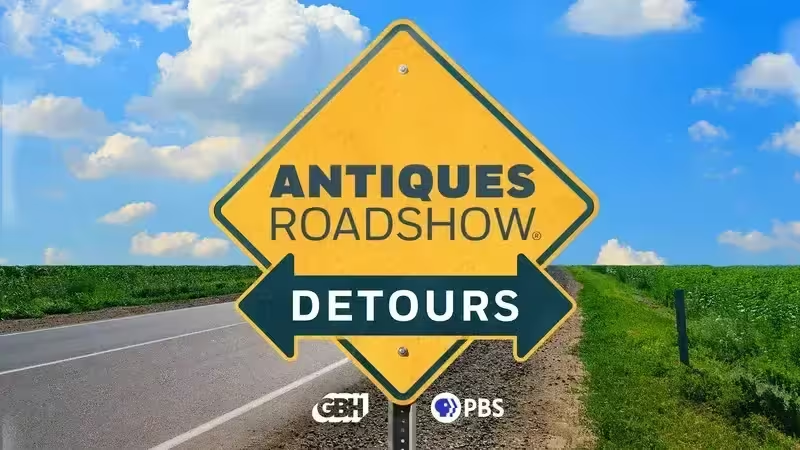
ANTIQUES ROADSHOW DETOURS
Ever wondered what happens to the treasures featured on America’s beloved ANTIQUES ROADSHOW after the cameras leave town? Host Adam Monahan tracks down the juicy afterlives of your favorite finds from PBS’s hit series.Providing Support for PBS.org
Learn Moreabout PBS online sponsorship♪ ♪ CORAL PEÑA: "Roadshow" has picked some delicious treasures at Denver Botanic Gardens Chatfield Farms.
My heart stopped when we saw it.
The color alone.
That's amazing.
Are you kidding?
Holy smokes!
Wow!
♪ ♪ PEÑA: For thousands of years, the land where Chatfield Farms is today was used as hunting and camping grounds by Indigenous people, including the Ute, Cheyenne and Arapaho.
Non-Native American settlements started to appear in the mid-1800s.
In 1866, the Hildebrand family set up a homestead here, and their ranch house is now listed on the National Register of Historic Places.
What historic treasures have cropped up today?
Take a look.
♪ ♪ Hello!
Hello!
Hey!
GUEST: I was told that my grandparents bought each other a dipper for their anniversary back in, I guess, the '20s.
Out of the well, you would want to dip your water and drink it.
So, I think it's a handmade deal.
But they used it back in the day.
It's one of the first ever made, and it's-- we got it as a gift from some of our family members.
My brother, he just kind of keeps it on his shelves in his room.
So we-- I've been collecting them for almost my whole life, so I have at least like, 15 or so.
GUEST: The Longmont Historical Society in Longmont-- it's a small town north of Denver-- has a fundraiser twice a year.
And we found this.
The man wanted $500 for it.
We walked around for a little while.
We came back, and he said, "All right, you can have it for $350."
So we said, "Okay, that sounds good."
And my husband is really good at researching.
He took the name "Amanda Strattan," and he was able to find out some information about her.
Okay.
She went to a school, I believe it was called the Tidball School, in Pennsylvania.
The school taught the young girls.
And we think she was nine when she did this, which is just amazing.
Okay.
She went on to marry a-a Civil War soldier, actually an officer.
She had two children, but she contracted cholera, and she died really young.
Oh, no!
So we kind of feel like we really want to preserve this.
And you're quite right, this was from a school in Bethel Park, Pennsylvania, which is today a suburb of Pittsburgh.
The school was in operation from about 1834 to 1854, so 20 years.
And we know that samplers were being made, at-at least at the school, at least until the 1840s.
There are at least 15 samplers from the Tidball School that are known.
The Tidball School is known for these very large, distinctive flowers.
What's unusual about this for the Tidball School is the great house in the middle.
You have a little dog here.
And then over on your side at the bottom, you see at least three sheep.
And the third sheep, he-he's sort of cut off.
And that's because the sampler is folded under.
Right.
And it's folded under because they put it in this awful drink tray!
(chuckling): Yes.
It's dated 1836, but the tray that it is in is probably from the 1920s.
It's terrible.
So it has nothing to do With the date of the sampler.
Right.
So what do you think it's worth?
Well, I-I think it probably is worth $500.
Yeah?
How about more than that?
How about, maybe, ten times more than that?
Maybe $5,000?
I-I think a good auction estimate would be $4,000 to $6,000.
Oh, my goodness.
So you got a great bargain.
You got something you really love.
Oh, my goodness!
(sighs) (voice breaking): I mean, we'll keep it forever, but... (inhales) I brought my Buffalo Bill poster.
Had it for a long time and just enjoy the living daylights out of owning it.
I found it at the old Mile High Flea Market.
There was a gentleman and he had literally hundreds of posters.
I worked out a deal with him to buy 'em all.
And it turned out he was the front advance man for Buffalo Bill Cody.
He would go to the towns in front of the show and leave posters in the walls, on the fences, wherever.
The semi-interesting deal of it?
He had been burning 'em.
He used 'em for fireplace starters for years.
And he had a neighbor over for dinner who asked if he should take 'em to the flea market, they might be worth something, and that's how I got it.
Do you remember what year that was, like when about?
1976.
How much did you pay?
I paid $3,000 for all of 'em.
And I sold the vast majority for almost double that.
The history of Buffalo Bill is very well recorded.
The man was the biggest showman in America, as famous as anyone could possibly be.
You say Buffalo Bill, everybody knew him.
His Wild West, his Congress of the Rough Riders, traveled around America, traveled around Europe.
People were enthralled with, uh, western expansion and-and the-the mythology of the West.
And he perfectly encapsulated that and played to that and became so incredibly popular.
And in the course of doing it, printed hundreds and hundreds and hundreds of different posters.
It was printed in Buffalo, New York by the Courier Lithography Company in 1902.
And it's a beautiful stone lithograph.
The-- as a printer, they were one of the top three or four in the country, and their work is magnificent.
They're like lithographic paintings.
And this really represents the height of their craftsmanship.
And "Buffalo Bill's Wild West" came into being in 1883, and it changed its name to "Buffalo Bill's Wild West and Congress of Rough Riders of the World" in 1893.
So this was later on in his career.
Now it is printed to look like it's on a tanned buffalo hide.
Yeah.
And on the tanned hide are all of these Native American pictographs, if you will.
That's cool.
Wonderful, classic imagery of Native American life.
My colleague at the tribal table also told me that these painted hides were sold by the tribes everywhere to Westerners who wanted a souvenir.
The painted hides had nothing to do with tribal life.
So these were souvenirs, and Bill knew that.
Buffalo Bill knew that, and he used them in his advertising 'cause he was playing to the Western ideal of the Native American.
This is a poster that someone cut around the lines just to highlight the outline of the piece itself.
This is a rare poster.
There is no other known copy that can be seen.
There are similar posters.
It's also been trimmed.
The condition isn't great.
We had it appraised... ...eight years ago, ten years ago, and at that time, we were told that they thought it could be worth $3,000 to $5,000.
Buffalo Bill, who was the most famous person in the world, you know, in the 1880s, 1890s, 1900s, who fell out of favor for a little while.
For some reason that I can't explain now, in 2024, he is going through a resurgence of popularity, and there are people who still cultishly follow him and collect his material.
And I say that endearingly.
(chuckles) Because most of them are my clients.
(laughs) I think if I had this at auction now, I would estimate it between $7,000 and $10,000.
If it was in its original state, I would estimate it between $15,000 and $20,000.
I-I did good.
(chuckles) I'm pleased, and I'm honored, and I'm thrilled from the bottom of my geeky poster heart to see this.
GUEST: This is my great-grandmother's chair.
It's from the Hudson Valley.
There's kind of a family lore story that, uh, it was made by a man who, uh, had back issues... (laughs) ...and he couldn't sit in any chair, so he made this one... (laughs) ...and sat in it.
(chuckling): I don't know how true that is, but, uh, yeah, we're here today to check it out and get some info.
GUEST: This is a Civil War drum.
APPRAISER: Mm-hmm.
And my wife's great-great grandfather fought in the 157th New York-- drummer boy by the name of Willie Lawn, his autograph is in here.
He was in Company G. My wife's great-great grandfather was in Company B of the 157th New York, with barely over 400 men.
That's incredible.
So he probably heard this drum.
GUEST: My grandfather had seven sisters and one of them was a fairly renowned antiques dealer in Joplin, Missouri.
Visited her house one time, it was just jammed with stuff.
So she gave this set to my mother and it was a wedding present.
Hm.
And my mom would always say, "May said this was "one of the finest examples of this type of work that she'd ever seen."
It's a beautiful service.
Nice.
It is a dessert service and it's complete.
There is what we would call a cake plate or a cake stand.
You can see there's a pedestal on this one.
And eight plates to go with it.
And they're in beautiful condition, which suggests they haven't had a lot of use.
These services were made typically with one fruit stand and eight plates.
It's rare to find more than one fruit stand.
Ornithological services typically depict birds.
And these are all hand-painted, very beautifully done, of a more exotic nature.
What I like here is that these are common British birds.
Oh, British.
Um, and common in this case is unusual.
Mm-hm.
Mm-hmm.
So, you know, here's a thrush, there are finches.
They're-they're common birds of a garden variety.
There is one that's an exception.
What is that?
Do-- have you noticed?
Well, I think it would be this one, right?
It would, the parrot.
Right, parrot.
And you don't see many parrots flying around naturally in the British Isles.
No.
I think someone has chosen-- whoever painted this chose the parrot, perhaps because that is a fruit stand or a dessert stand.
And fruit, after all, in Britain, is mostly exotic.
Right.
Now, I don't know who made it and I don't know who painted it.
Almost certainly made in the county of Staffordshire or very nearby.
I think these are probably mid-Victorian, meaning made perhaps around 1860 or 1870.
There are no marks on them.
There was a time when services of this type were more valuable, frankly, than they are today.
A retail price, it's going to be at least $1,000.
Okay.
And possibly a dealer would price it at $1,500 or $1,600.
Okay, great.
PEÑA: There are 11 historic structures at Chatfield Farms.
And two of them, a 1918 restored dairy barn, and a silo that held grains like corn, are picturesque elements of agricultural life.
A later addition to the farm since it opened in 1989, a schoolhouse built in 1874 that was moved from Deer Creek, Colorado.
GUEST: Well, my parents bought it.
I'm from Chicago, from the South Side of Chicago.
My parents purchased it at the Hyde Park Art Fair, 1963.
It could have been '64, but I do think it was '63.
And it was hanging on their walls for my entire childhood.
And then when they both passed away, it-it came down to us.
Do you know if they purchased it directly from the artist?
They did, he had a booth at the Hyde Park Art Fair, and he would come every year.
How much did they pay for it?
$75.
When my parents passed away, because I loved the picture so much, I found the artist's email address and I wrote to him and he was kind enough to write back.
I sent him a picture of-- an email of the, of the art and he wrote to me about it and-and told me a bit about it, which was wonderful.
Well, that's very generous-- a lot of times... Yeah.
...you don't get that kind of reaction.
No.
You either get ignored or, or... or something else, right?
Right, exactly.
I expected to be ignored, I did.
(chuckling): Exactly.
But it meant a lot to me.
So, as it turns out, you do have a-- part of that, uh, email.
Do you mind reading what he said?
I do.
He wrote that he had returned to watercolor in 2003.
"I probably haven't used it since the '60s.
"And I observed some delicate and sensitive use of watercolor "in this painting that I still admire.
Frankly, I think it's a very fine painting."
So he loves his work.
(chuckling): That's excellent!
That's excellent.
He endorsed it.
He did.
He did.
And you know, I noticed the painting is not signed.
So having that information actually confirms the fact that he did the painting.
Right.
He did.
This is a watercolor painting by Wadsworth Jarrell, probably done in the '60s, as you just indicated.
Yes.
And the subject matter is Charlie Parker on the saxophone and Dizzy Gillespie on the trumpet.
Wadsworth Jarrell, he was born in 1929 in Georgia.
Okay.
He later moved to Chicago...
Didn't know.
...and he actually had, uh, some instruction at the Art Institute of Chicago, as well.
Wadsworth Jarrell was a co-founder of AfriCOBRA, which was founded in Chicago in 1968.
Okay.
AfriCOBRA actually stands for African Commune of Bad Relevant Artists.
(chuckles) He's still alive, he was born in 1929.
Yes!
But he's still with us.
Amazing, almost, okay.
90s.
In his, in his 90s, yeah.
But a painting like this, I think I would put an insurance value of $75,000.
Oh, my God.
(groans) $75,000?
Yes.
Okay, wonderful!
It is.
(chuckles) It's wonderful, it's worth it, it is worth it.
It's a wonderful painting and we're very grateful.
GUEST: This is my grandmother's brooch.
She was Belgian.
When I was younger, I always remember her wearing it.
And it was something that was really special to her because her husband, my grandfather, they were both around during World War II.
My grandfather was in a concentration camp for printing false documents for Jewish people to help them.
And, um, when he came back, um, he had brought-bought this for her.
And he was not Jewish?
No.
Yeah, so extremely noble and-and, you know, really brave.
The piece is definitely European.
It is gold.
Okay, great.
Has a very heavy patina on it.
They are diamonds, they're rose cuts.
This is probably from 1915 through, like, '25.
If I had it in an auction, I would put it in for $2,000 to $3,000.
I know a lot of people don't wear pins today, but it's, it's really wonderful.
I would say that the, uh, ladybug ended up being good luck.
Yeah.
GUEST: Well, in 1964 and 1965, my sister Jan and myself joined the Ed Pazdur Teen Club in Chicago.
We had to buy the most expensive tickets to these concerts and everything; a whole season full.
And then we got to meet the groups in person.
And there was a card that usually was sent in the mail a few days before we were supposed to meet them.
It was like a big secret, because they didn't want...
Right.
...all the groupies coming.
We did get to see many of the groups, and they all sat at these big, long tables, and then we could get their autographs and everything.
And my sister took some pictures, too, so it was a lot of fun.
(chuckle) The first band here is the Yardbirds, who are an English band.
One of the most recognized guitarists of all time, Jeff Beck, who sadly passed recently.
He was a member of the band.
We have... ...another British band, The Kinks.
Fantastic-- what I would say-- are probably unpublished photographs of the band taken at the time.
All really good, the array and Dave Davies of the Kinks and the rest of the band.
And on the following page, we have the Kinks' autographs here.
And we come to The Rolling Stones.
This is a group of autographs, and they're all, they've all got a common theme; it's the British Invasion.
So the British Invasion were a group of bands in the mid-1960s who came over from England.
They basically took the U.S. by storm.
You've got two ticket stubs here.
Mm-hmm.
There's one from 1964, and there's one from 1965.
The 1964 tour was not very successful for The Rolling Stones, because they weren't particularly well-known.
They didn't have a hit single that was out at the time.
So a lot of the American fans didn't really understand who the Stones were.
And it wasn't until 1965 that they became really successful.
So you got Brian Jones.
Bill Wyman.
Keith Richards.
Mick Jagger.
Charlie Watts.
I've noticed also you've got a Bill Wyman, an extra Bill Wyman autograph.
Afterwards, we went into the ladies bathroom and I saw that on the floor.
Oh.
And I thought, well, I'll pick it up and I think on the reverse side is some kind of a fan club or something like that, so some poor girl lost it.
I felt really bad in a way but I picked it up and I kept it.
So that's a bonus.
I figured, that's a nice signature on there.
If we were to take just, say, The Rolling Stones, a conservative auction estimate just for these pages here-- you've got unpublished photographs, you've got two ticket stubs and you've got the full set of signatures-- conservatively between $2,000 and $4,000.
Wow.
If you were to look at selling the entire package at auction, the whole album would be worth in the region of $6,000 to $8,000.
Wow.
I would certainly insure it for around $15,000.
Wow.
It's a fantastic collection.
Oh, that's excellent, yeah, very happy.
(chuckles) GUEST: My father was stationed in Okinawa at the end of World War II, and he was a gunner on a B-24.
After the war, he worked in the kitchen on the base.
Mm-hmm.
He would trade things for art and-and collectibles.
He brought it home and he kept it in a folder for probably about 40 years.
Oh right, yes.
And then I discovered it, and asked him one year to give it to me for my birthday.
Oh, right.
And he did that.
He did, yeah, you like it, right?
I love it.
It's a Japanese printmaker called Hasui.
H-A-S-U-I.
He signed "Hasui" here.
"Hasui" here.
Okay.
Oh, uh-huh.
The signature.
And then the seal.
But his, uh, full name was Kawase Hasui.
Okay.
Kawase was the last name, was born in 1883.
Kawase Hasui was very influential...
Okay.
...in making this traditional print into, like, new type.
Okay.
And this-this color, use of color is wonderful.
Wow, yes.
And it ver-- became very popular among American people.
Okay.
Okay.
Uh, popular in Japan, too.
Mr. Steve Jobs... Oh.
...loved this artist.
Okay.
And he had about maybe dozen or 20 in his collection.
My goodness.
In America, this-- his price is going up now.
Oh, boy, okay.
You were lucky!
It's in Hiroshima prefecture, east of Hiroshima, an hour away.
Mm-hmm.
And it's a seaside.
He carved this in 1940, but he kept printing.
There's a publisher name.
Oh.
Publisher is very famous too, called Watanabe.
From this publisher's mark, you can say it's in the mid-1940s.
Okay.
Conservatively, in auction, you say $2,500 to $3,500.
(inaudible) Oh my, wow.
If the color was a little bit better, it could maybe go for over $5,000 too.
Wow.
Today, I wasn't going to get the hat appraised.
I wore it because they said that it was going to hail possibly, So I wanted a hail helmet.
Everybody was talking about the hat standing in line, so I decided I would check it out.
I think it's a Tyrolean hiking hat and that the previous owner would hike to different places and then they'd get a pin to get a memory of where they'd been.
This was given to my brother for payment for helping some people move.
And so then my mother inherited it from my brother.
And then she gave it to me.
I'm kind of thinking maybe around 1980, 1990.
It's titled "Lullaby."
GUEST: I brought my mom's WASP jacket.
Women's Air Service Pilot during World War II.
And the telegram telling her she was in from Jackie Cochran.
And the wing.
She had an extra set, because the-the real ones weren't ready for their graduation.
And then, of course, a photo.
She loved to fly.
That's all she ever wanted to do was fly, and she got to fly for her country, it was... it was an honor.
She towed targets for gunnery practice with live ammunition, and she ferried some planes when they were repaired.
It's an A-2 flight jacket.
These were made in the '30s and into the middle of World War II for all of the aviators and anybody else who could get their-their mitts on one.
This one's made by Star Sportswear in Lynn, Massachusetts.
But the thing about this one that sets it apart from all the others is the fact that this is an A-2 to a WASP, and more specifically, to your mother.
And she's wearing her-her blue uniform with the class wing there, it looks like.
Yes.
You have three wings.
You have the WASP wing, you have the class wing, and then you have this Women's Auxiliary Ferrying Squadron wing.
Right.
How many WASPs did serve in World War II?
Just over a thousand.
So for everybody who has a World War II exhibit or display, who's wanting to put WASP wings or anything WASP related in that display, these things are very hard to find.
Yes.
And what normally happens in those circumstances is that there are fakes and forgeries made aplenty.
And one of the easiest things in the wing world to get burned on is a pair of WASP wings.
The real wings were all made by Josten.
And they were all clutch back as opposed to pinback.
This one has that mark, and this one is clutch back.
This one meets the criteria.
It flew everywhere my mom did.
The class wing is made in pinback, and that is correct, with the class insignia on the front.
The one with the enamel here is kind of a rare one.
This is the Women's Auxiliary Ferrying Squadron.
Note that on the very bottom of that, it says "civilian pilot."
Right.
And that's what they were.
They were.
According to Uncle Sam at that time.
Yeah.
They were civilian pilots.
During World War II, what was the duration of her service?
20 months-- she went in-in 1943, and late '44, and then right after that, they disbanded the WASP.
It's one thing to find a pair of wings out in the world.
It's quite another thing to find wings or other material that is specifically identified to an individual.
Because at that point, you don't just have WASP wings, you have her wings.
And for all of us who love these things, that makes them more significant.
The items that you brought here that we have out, are going to range in retail between $13,000 and $19,000.
Wow.
I did not expect that.
(chuckles) She was one in a million.
An identified WASP A-2, is easily a $5,000 jacket.
GUEST: It was given to us by a good friend of my wife's mother, and it was from her family and we think it was in the 1800s this... Mm-hmm.
...the dress was made.
My wife is a home EC teacher and so she was very interested in all the work that went into making the dress.
It was given to my wife about in the 1960s.
It's earlier than you think.
It is a very rare example of an indigo printed cotton dress.
That dates to 1798.
Or thereabouts.
Oh, my goodness.
This type of printing was very complicated.
And so we as Americans, just a few decades after the Revolutionary War, we didn't have that skill and that infrastructure to make this type of multi-process printing.
And so there is very good possibility the fabric, at least, comes from England.
It's in wonderful condition.
It's a glazed cotton and I can see around certain areas it's a little shiny.
It is lined-- the bodice is lined with a very heavy linen to kind of keep body sweats away.
It has a pull drawstring tie at the top and one on right at the bodice.
And the inside, there's just a little opening.
You can see there is sort of a flap closure inside, just for modesty's sake.
The aspect that really helps us z-zero in on the date is all in the back.
We have a really tight triangle piece that's put here with amazing, tiny little hand-done pleats.
Everything is hand-handmade here, um, and a lot of fullness.
This is a pleating with a lot of fullness in the back.
Later on, even ten years later, five years later, we slowly start to see this more like a column.
But this sort of nice sweep and fullness at the back is helping to date it to the very late 1790s.
Had you ever thought about the value?
No, we've never really worried about it.
My wife just said it's just a museum piece and we just need to keep it because it's a very valuable dress.
She is absolutely right that it's that's the kind of level of dress it is.
It is a very elevated, up-to-date day dress in great condition.
For insurance purposes, you would have an insurance value of $15,000.
Oh, my goodness.
That's amazing.
It-it's very rare.
Unsuspected.
(chuckling): Unsuspected.
My heart stopped when we saw it!
(chuckling) The color alone and then looking at it... Yeah.
...and dating it to that early, there was a lot of excitement on the table.
So, um, thank you so much for bringing it in.
Okay.
Well, we appreciate all your help in telling us more about it.
GRACE JOHNSON: Aquilegia coerulea, or the Colorado Blue Columbine, which is the state flower of Colorado, is a really interesting flower.
Very easy to grow, they can tolerate sun or part shade.
It has a variety of different colors and different cultivars.
You can get the typical blue native color.
There's red, there's golden columbines as well.
And it will reseed quite a bit in the garden as well.
So you get some free plants out of the deal, which is something I really enjoy.
GUEST: My grandfather was an insurance man in Ohio.
APPRAISER: Mm-hmm.
And he collected fire marks and other fire memorabilia.
And this was part of his collection.
For a very long time, most firefighters were volunteers.
If you had a fire in your village, you form a bucket brigade and try to put out the fire.
And firefighting has been a profession for a very long time.
But it wasn't until the 1850s, 1860s, where firefighting uniforms really kind of took off.
This is an all-leather helmet made by Cairns Brothers in probably late 1800s, early 1900s, all hand-stitched and really an interesting helmet.
The fire helmet is what we call a New York style, and conveniently, is from Cornwall, New York.
And this is what we call a Philadelphia-style fire hat.
It was a very popular style, and it's called the Philadelphia style because, well, it was popular in Philadelphia, but it was also used in Baltimore and Washington, D.C. And it was used mostly in parades.
It was popular from the 1830s to 1870s, 1880s.
You can tell from the inside it was made from pressed felt.
Hm.
And then it's just been painted over.
You can see the raw felt underneath.
It was thought that the green brim would help you maintain your vision in bright sunlight.
And you see a lot of 19th century and early 20th century helmets having a green brim on 'em.
This 1910 Cairns Brothers fireman's helmet is not uncommon.
All ordinary wear and tear and damage.
There are no signs of abuse in this helmet.
Mm-hmm.
Just use.
Okay.
This leather fire helmet, I give it an auction estimate of $600 to $800.
Okay.
This Philadelphia-style parade hat is particularly rare, and they're fragile.
The paint helps to stiffen it.
But it won't stop it from being crushed or damaged.
This is in very good condition.
It appears to be in original condition.
And because of that, it has a very high value in the parade hat world.
Hm.
I would give an auction estimate for that one of $15,000 to $18,000.
That's amazing.
I-I never would have guessed.
GUEST: I bought this doll about ten years ago.
This is the No.
1 Barbie that was produced in 1959.
What makes it distinctive are the holes in the feet.
And it had a special stand.
And then also her face is very distinctive in that it has white irises.
And this is a special outfit called "Gay Parisienne," which was only made a couple of years.
Well, you were very accurate on your description.
I'd like to point out that the doll also has the original rubber band on the ponytail.
Yes, it does.
That means a lot to Barbie collectors.
Yes, it does.
Well, now, what did you pay for it ten years ago?
I paid about $2,000.
Wow.
(laughs) I hope it's worth more than $2,000.
(laughing) (laughing) Well... it is.
And the movie that came out on Barbie has really affected the price of-of these dolls.
And on today's market, it would be between $9,000 and $12,000.
Wow, that's wonderful.
(laughs) This outfit's very rare.
And if you just sold the outfit, it would be $1,500.
GUEST: So, I'm an architect.
It happens that a client of ours bought a warehouse in downtown Denver.
The seller of the-the warehouse had owned it for at least 40 years Hmm.
And he was a well-known car collector.
At one point there were 70 Porsches in there.
Oh, wow.
Also just a lot of odd, interesting pieces that he'd found, uh, during his life.
Including this.
(stammering): Yes.
And he had to surrender it all.
He was in his dotage and didn't have anybody to leave it to.
Okay.
So at some point you surrender it.
So our client said, "Hey, see what you can do with this."
And I tried to save as much as I could from going in a landfill.
Okay.
And this was a piece that I found that I-- that just absolutely fascinated me.
Luckily it had a tag on it that it is a prototype model for a mold to make alkali balls, presumably for water treatment.
The only thing I can find for the inventor or for the object at all is in the patent registry... Mm-hmm.
...that there it is in 1881 with a scan of the, the little hand diagram.
This was patented on February 22, 1881 by, I believe, it's Minard M. Smith.
Smith.
It's carved from wood.
It has some metal elements-- the hinges, the springs, the wires and a little set of latches there that allow us to close and open the mold.
You can see all the cavities inside.
There you've got one of the original wires which, uh, I suppose, once you're done making those alkali balls, would allow you to remove them... Mm-hmm.
...from the mold.
Patent models, very sought after by collectors because, by definition, they're one of a kind.
In a auction, a well-advertised auction, I would expect a patent model like this to sell somewhere in the range of $2,000 to $3,000.
Ah, okay.
Okay.
Yeah, so not bad for saving it from a, a building or... From a dumpster, exactly.
Yeah, from a dumpster.
Yeah, it's fascinating.
Yeah.
GUEST: I brought a chest that my mother bought at a house sale in the '50s, and this was actually in the garage.
It was all painted gray, and the man was storing his tools in it.
So, I-- it's quite a tool chest!
And her friends-- Yes!
And her friends told her to buy it.
And one of the friends said she thought it was Dutch and thought it was really old.
And so where was the estate sale?
In Winnetka, Illinois, uh.
So she had the paint taken off... She did.
...and brought down to the natural wood.
Would it surprise you if I told you this was an Italian Renaissance piece from the 17th century?
So it's-- Oh, my gosh.
So it's not Dutch.
No.
And it's seven-- isn't that 16-something?
Yes.
Oh, my gosh, Andrew.
Yes.
That's lovely.
It's probably about 1620 to '60.
It's made out of walnut.
What I absolutely love is on the front you've got these tapering pilasters which are reminiscent of Roman architecture and columns.
So if we pull the drawer out, take a look at the way it's constructed.
The Italians tended to use thick boards for the secondary wood and not very highly finished.
But they did take the time to-to chamfer the drawer on a 45.
And if we look at the drawer apron, you can see right here, they've chamfered this opening right here on a 45 to mimic the drawer front.
So this provides a much tighter, seamless fit.
And if we look on the backside... Uh-huh.
...you've got these backboards that aren't finished.
And that's the way the Italians made it.
But, you know, this one is, is done pretty nicely.
For something that's from the 1600s, 17th century, it's in pretty good shape.
And we've got some worm damage on the top.
And if you look at this corner, you can see there's been a-a patch to it.
I can see in the front here we-we had a-a different lock at one point.
Yes.
And if we continue down, these foot facings were replaced.
I wondered about that.
Now, maybe the man who refinished it for my mother did that?
I don't know.
It's always been like this since I've known it.
You probably didn't know what your mother paid for it, right?
I didn't, no, and she never would have told us 'cause she never wanted my dad to know what she paid for stuff.
(laughs) I love it.
So, yeah, she wouldn't have told us.
If you want to keep it in the family... Mm-hmm.
...I would probably insure this for $2,000 today... Oh, my gosh.
Oh.
...which is, it pains me to say that, because I think it should be so much more.
Stylistically, not as many people want to decorate with this heavier furniture.
Oh no.
Mm-hmm.
GUEST: I believe it was my grandmother's.
I don't remember my mother ever wearing it.
I have worn it very occasionally.
So you have yellow gold on the back side and platinum on the front side.
And the reason that is, it's to make the, those diamonds really pop up and shine.
So we have a total carat weight of two and a half carats.
This piece is what we call Belle Époque because of the very distinct ribbon patterns.
It's very characteristic of the time period of this type of jewelry.
I see you have a chain there.
Did you add that to the piece?
Yes, because the clasp is not secure.
Okay.
And I almost lost it once.
There is a hallmark on the very top portion.
I was able to make out a signature there of Tiffany & Company.
If this was not a Tiffany & Company brooch, we would put a auction estimate of maybe $1,000 to $1,500.
But because this is signed, this would have an auction value of closer to $10,000 to $15,000.
Oh, my goodness.
That's amazing.
Yeah.
If this was in a retail shop, we found some that are selling closer to $20,000 to $30,000.
Oof.
(laughs) (laughing): That's a little shattering.
Yeah.
It's a family piece.
It's probably not going anywhere.
I don't blame you.
That maybe back in the safety deposit box.
GUEST: This is part of a collection that my wife got through her family.
And these are Edward Curtis photographs.
So he was a photographer, I think, from 1868 to 1952.
And he took a lot of Native American photography.
So we're not sure exactly what degree of originality they are, but rumor is that they're kind of made off of the original photograph plates that he had created.
So we're excited to find out.
GUEST: This is a, uh, Gibson L-G2.
When I was ten years old, I had a serious bike accident and had a brain concussion.
And just a few months later, my father got me the guitar.
I had been playing a clunker for a while, or trying, and so he got me a good guitar.
And so it's 66 years old, at least, and that's all I know.
GUEST: My parents bought this, I believe, in the early '80s from a gallery.
Uh, it was either down on Larimer Square here in Denver or in Santa Fe, I'm not sure which.
And it's been hanging place of pride in our living room ever since, um, the house I grew up in.
It's been a constant presence in my life, you know, as a child.
And it's just such a beautiful piece of work, and we're just really very happy.
Mom had a great eye for art.
Her name is Jaune Quick-to-See Smith.
She was born in the 1940s in Montana.
Mm-hmm.
She's a Native artist of French Cree, Shoshone and Salish blood.
So you mentioned this is, was purchased by your parents.
Do you remember how much they paid for it?
I don't know, and my father doesn't either, unfortunately, so... (chuckling): Okay.
He just said it was, you know, they, they spent some money, but.
It's an original artwork.
Okay.
It's a print... Mm-hmm.
...but it's a monotype print, Okay.
...which is a-a process that you take a painted surface and lay it down on paper.
All right.
And then if you do it a second time, you get sort of a more ghostly image.
And this is a ghost image.
Hm.
Okay.
All right.
So this is the second time they've applied the wet paint to the paper... All right.
Okay.
...and then pulled it away.
And then she accentuated it.
You can see paint applied in the dotted areas.
Okay, yeah.
And then other details.
It's a double, uh, matted frame... Mm-hmm.
...so I really can't tell what kind of paper it's on.
All right.
But it could be in a-a really important, um, archival type of paper...
Okay.
...for this type of thing.
Sure.
And she signed it in pencil at the bottom.
It's a very early work by her.
Mm-hmm.
Roughly ten years ago, um, she had, oh, I think, a workshop and an exhibition in the Loveland, Colorado Museum.
Uh-huh.
And she was there, and so my parents, Dad took a picture on his phone or his iPad and took it down with mom, and they met her.
And they-- That must have been exciting.
Yeah.
They-they were just so thrilled afterwards.
But they said she just lit up, and she was so thrilled.
She said, "That's really an early, early one of mine."
She goes, "That's one of my first."
And she was very pleased to see it, so.
Yeah, it's probably from the 1970s.
This is typical of the manner she works in.
Mm-hmm.
She's an extraordinary artist... Yeah.
...that is now getting major recognition.
Yeah.
Although this is original work of art, it's still considered a-a print.
If this was come to market today, it would sell for between $30,000 and $60,000.
Oh, wow.
Okay.
All right.
Her pa-- her paintings have done-- have jumped.
They've gone into the six figures.
Mm-hmm.
PEÑA: Colorado is one of the top states for butterfly diversity.
And hundreds of native butterflies can be found here at the Butterfly Pavilion.
Beautiful pollinators like monarchs, eastern commas, and red admirals and Julia butterflies are attracted to the nectar of the native plants grown here.
GUEST: In the spring of 1982, my parents took a trip, and they went to China for a month.
And they traveled all over, and they came back, and they were fascinated by the beautiful things they'd seen there.
And in downtown Denver, there, uh, was a Chinese, Asian, uh, shop.
Pretty soon, things started showing up.
And I didn't pay much attention to 'em.
But then as more came and more came, I really did kind of like them very much.
My dad told me that this was from 2000 BC.
It was so breathtaking to me that I could hold something (chuckling): from 2000 BC.
(chuckles) (chuckling): This is not that old, unfortunately, which is not a reason to be discouraged.
Okay.
It is old.
These are all antiques in their own respect.
Represented here at the table, there's a wide variety, not just stylistically, but in terms of the ages of when these were produced.
This jar is, I think, from the region of Henan in China.
But I think it dates from around the year 1200 or 1300.
So it's a really, it's a nice considerably old piece, but one that probably dates from the Song dynasty in Chinese history.
This very cheerful footed dish in the form of a fish has a six-character mark on the bottom.
And this indicates the Ming dynasty.
Okay.
"Da Ming" being at the beginning.
Th-this is from the Xuande Emperor.
And then this just says "period made."
But it's not of that period.
It's not of-- no, this is actually, this is actually something later.
We're gonna come finally to this blue and white dish.
And this has what's called a rain mark on the base.
It's this square seal.
"Da Qing Qianlong, the Emperor, period made."
"Qing Dynasty, Qianlong, period made."
This is something that is very much firmly in the imperial style.
This is an imperial dish that dates from the 18th century that would have been made at the imperial workshop... Oh.
Wow.
...in Beijing for use within the Forbidden City.
Wow.
This is actually the treasure of the group.
Wow.
Huh.
It's difficult to find this kind of porcelain in the market right now.
It's what the Chinese, who are driving the market, are really yearning for.
There's actually a price tag on this-- and we don't know if that's what they paid... Yeah, I don't know.
...probably something-- of $500.
Yeah.
The value on this has increased tenfold.
So I'd put, at auction, a value of $5,000 to $7,000... (laughing): Oh, for heaven's sakes.
...for this dish alone.
I almost didn't bring it.
(laughs) That's quite a surprise.
This would be more $700 to $900, maybe $800 to $1,200.
Okay.
This dish, 19th century.
It's actually the newest of the three...
Okay.
...that are here on the table.
And this one, I would put an auction value probably $800 to $1,200 or so.
Okay.
Okay?
Wow.
GUEST: These are two Sam Maloof walnut woven benches... ...that I obtained from my aunt and uncle's estate.
My uncle was a renowned, uh, modernist architect in Riverside, California.
Mm.
And he knew Sam Maloof personally and had quite a few pieces from Sam.
Mm-hmm.
Sam Maloof is certainly one of the "A" guys of 20th century design.
There's no two ways about it.
He started working about 1947, 1948 in Southern California.
He's one of the few people to do wonderful craft furniture in Southern California.
It's incredibly well-built.
It's incredibly well-designed.
He tended to make the same things pretty much throughout his career, so he got really good at them.
So these are two great Sam Maloof benches.
They're from 1974.
You could buy a single, a double, a triple.
I don't know if he made longer than triple.
I've never seen one.
Mm-hmm.
But they are incredible.
You can see all the detail.
So these are signed.
Sam Maloof signed a lot of his furniture.
He didn't use a lot of hardware in his material.
Very few screws or brackets or braces.
The walnut is gorgeous.
So, it's so beautiful.
It's so well-colored.
It's also aged very well.
His most popular piece is a rocking chair.
Maloof rocking chairs.
Oh.
The benches are rare.
They don't show up as often.
Mm.
People really covet them.
Do you have any idea what these might be worth?
We had a-a-a sheet that I got from my cousin.
It was an appraisal from the Sam Maloof Workshop, uh, I believe in 2013 for insurance purposes.
And I believe they were appraised at that point for replacement value of $8,000 each.
Mm-hmm.
Maloof's furniture has become very popular.
For insurance purposes, I would value these at probably $12,000, $13,000, $14,000 apiece.
Oh.
(chuckles) These are great pieces.
They're really rare.
Yeah.
Geez.
Yeah.
Wow.
(chuckles) Yeah.
(sniffs) Yeah, that's, that's, yeah, that's, that's way more than I'd... than we had estimated they'd, they'd go for.
Of course, they're great pieces.
I mean, they're a great memory of my aunt and uncle's house.
And, um, of course, we certainly plan to hold on to them.
And hopefully our sons will enjoy them, and pass them down, but, uh, wow.
GUEST: All I know is it's a 360-year-old Belgian crossbow.
I'm assuming this is where the, some arrows would go.
But I don't know.
Obviously, you can see here it's got this, so, you know, weird, huh?
GUEST: This is my grandmother's set of silverware.
Never use it, so.
Need a special occasion, I think, for that.
Not dishwasher safe.
GUEST: They're from my dad.
He won four consecutive gold medals in the discus; '56, '60, '64 and '68.
And each time he also set an Olympic record.
He was just the greatest guy.
I just miss him, and I love him so much.
He was goal-driven, but back when he was in the Olympics, you had to be an amateur.
So he had a full-time job.
He would lift weights on his lunch hour, throw after work, and usually take my sister and I when he would go throw.
And he made a comeback in '80, which we boycotted.
And he probably would have made the Olympic team if it wasn't for the boycott.
Then he made a comeback in '84, was throwing world-class, but got injured at the trials.
And what you brought in were your dad's, Al Oerter's, four gold medals from four consecutive Olympics, all for the discus throw.
How did he get into throwing the discus?
Oh, that's a great story.
(chuckles) I'm glad you asked that.
So in high school, he ran track.
And he didn't like running track because that was too much work.
So at one point in time, a discus skipped over the track.
He picked it up and threw it, and it threw over the discus ring.
No!
So the coach said, "You.
Over there," and that was it.
And he won the nationals, high school nationals.
And he won his first gold medal when he was in college.
So it was very quick; he-he was meant to be a discus thrower.
This is a discus you brought... Mm-hmm.
...that he used for practice, right?
Yes.
Mm-hmm.
But i-if you look here, it says "Al Oerter Olympic Gold '56."
And these are all the lengths of his record throws.
Yes.
184, 10 inches; 194, two; 200 feet, uh, one inch; and then 212 and six.
Uh-huh.
So over a 12-year period, from the time he was 20 to 32, he just got better.
Yes.
We've got the '56, the '60, the '64 and the '68 medals.
I'm gonna talk about these three first, because if you notice that they're so shiny, it appears that they may not have the original finish on them.
Correct, correct.
The New York Athletic Club, for his 50th birthday, re-gilded them.
And then the '68 medal... That medal is not actually the medal that was put around his neck.
Okay.
What happened was, there was a movie made, and they needed a mold for '68 Olympic gold medals.
So my dad gave it to them.
Well, they didn't tell the mold-maker it was an original medal, so it was destroyed.
But they did get the molds from Mexico City.
So it is from those molds.
And then you have this fabulous family photo from 1968.
(laughs) Yep.
Your mom, you?
Yep.
Your dad and your sister.
Uh-huh.
What's fascinating about discus is that it actually started with the first, uh, ancient Olympics... Mm-hmm.
...back in 776 B.C.
We're gonna value it as a collection.
I'm gonna value it for insurance value.
Okay.
Okay?
We have pros and cons.
Okay.
Now the pros are that your father was the greatest discus thrower of all time.
I don't think anyone can argue that.
Uh-huh.
Now the con is another value factor, condition.
And this is a copy.
Right.
So, and with copies, they are generally worth a fraction of what an original is.
And the total value here for this copy is the association with your dad and his career.
Uh-huh.
I would place an insurance value on the whole collection here at $400,000.
(bursts into laughter) (laughing): Are you kidding?
Holy smokes!
Wow.
That's impressive.
Wow.
Dad would get a kick out of this, boy.
Let me tell ya.
PEÑA: You're watching "Antiques Roadshow" PEÑA: And now it's time for the "Roadshow" Feedback Booth.
Today we brought this 1970s mid-century modern electric art piece.
Nobody could figure out anything about it.
And this signed Milwaukee Brewers baseball with the signatures of Robin Yount and Hank Aaron from the '70s.
Total insurance value for the both pieces, about $1,000.
It was a wonderful experience here at the "Antiques Roadshow."
It was a dream come true for both my niece and I.
The appraiser is telling me that my grandfather's 1934 National Motorcycle Polo Championship trophy is worth about $4,000.
And the appraiser also told us that my great-niece Maggie is priceless.
(soft chuckle) We brought today our great-great-grandmother's diamond engagement ring, which is about one carat.
And it was upstaged by our Panama hat that was actually made in Ecuador.
So, thanks, "Antiques Roadshow."
We love you, Kevin.
We love you, Kevin.
(soft chuckle) It's a Japanese vase... Yup.
...made in China.
Made in China (all laughing) And it's got...
I guess-- I guess we also learned that these birds are, um, chickens and not peacocks.
(all laughing) We also learned that it's not gonna make us rich.
But that's okay.
We had a fantastic time.
(giggling) We watch the show all the time.
So it was wonderful actually experiencing it.
We're lucky we won tickets.
We're huge fan girls.
We met a lot of our favorite appraisers.
BOTH: Love you, "Antiques Roadshow."
PEÑA: Thanks for watching.
See you next time on "Antiques Roadshow."
Appraisal: 17th C. Italian Renaissance Walnut Cabinet
Video has Closed Captions
Clip: S29 Ep12 | 2m 39s | Appraisal: 17th C. Italian Renaissance Walnut Cabinet (2m 39s)
Appraisal: 1836 Mary Tidball School Sampler
Video has Closed Captions
Clip: S29 Ep12 | 2m 56s | Appraisal: 1836 Mary Tidball School Sampler (2m 56s)
Appraisal: 1881 Alkali Balls Mold Patent Model
Video has Closed Captions
Clip: S29 Ep12 | 2m | Appraisal: 1881 Alkali Balls Mold Patent Model (2m)
Appraisal: 1902 Buffalo Bill's Wild West Poster
Video has Closed Captions
Clip: S29 Ep12 | 4m 1s | Appraisal: 1902 Buffalo Bill's Wild West Poster (4m 1s)
Appraisal: 1956 - 1968 Al Oerter Olympic Collection
Video has Closed Captions
Clip: S29 Ep12 | 3m 47s | Appraisal: 1956 - 1968 Al Oerter Olympic Collection (3m 47s)
Appraisal: 1974 Sam Maloof Benches
Video has Closed Captions
Clip: S29 Ep12 | 2m 12s | Appraisal: 1974 Sam Maloof Benches (2m 12s)
Appraisal: Barbie Doll with Gay Parisienne Outfit, ca. 1959
Video has Closed Captions
Clip: S29 Ep12 | 1m 19s | Appraisal: Barbie Doll with Gay Parisienne Outfit, ca. 1959 (1m 19s)
Appraisal: British Invasion Concert Scrapbook, ca. 1965
Video has Closed Captions
Clip: S29 Ep12 | 2m 59s | Appraisal: British Invasion Concert Scrapbook, ca. 1965 (2m 59s)
Appraisal: Chinese Porcelain & Stoneware Collection
Video has Closed Captions
Clip: S29 Ep12 | 3m 10s | Appraisal: Chinese Porcelain & Stoneware Collection (3m 10s)
Appraisal: Cotton Printed Women's Dress, ca. 1798
Video has Closed Captions
Clip: S29 Ep12 | 2m 39s | Appraisal: Cotton Printed Women's Dress, ca. 1798 (2m 39s)
Appraisal: Diamond & Gold Maple Leaf Pin, ca. 1920
Video has Closed Captions
Clip: S29 Ep12 | 1m 2s | Appraisal: Diamond & Gold Maple Leaf Pin, ca. 1920 (1m 2s)
Appraisal: English Porcelain Ornithological Dessert Service, ca. 1860
Video has Closed Captions
Clip: S29 Ep12 | 2m 24s | Appraisal: English Porcelain Ornithological Dessert Service, ca. 1860 (2m 24s)
Appraisal: English Pub Clock, ca. 1860
Video has Closed Captions
Clip: S29 Ep12 | 1m 3s | Appraisal: English Pub Clock, ca. 1860 (1m 3s)
Appraisal: Fire Helmet & Fire Parade Hat
Video has Closed Captions
Clip: S29 Ep12 | 2m 9s | Appraisal: Fire Helmet & Fire Parade Hat (2m 9s)
Appraisal: Jaune Quick-to-See Smith Monotype, ca. 1970
Video has Closed Captions
Clip: S29 Ep12 | 2m 39s | Appraisal: Jaune Quick-to-See Smith Monotype, ca. 1970 (2m 39s)
Appraisal: Kawase Hasui Woodblock Print, ca. 1945
Video has Closed Captions
Clip: S29 Ep12 | 1m 58s | Appraisal: Kawase Hasui Woodblock Print, ca. 1945 (1m 58s)
Appraisal: Tiffany & Co. Diamond Brooch, ca. 1900
Video has Closed Captions
Clip: S29 Ep12 | 1m 40s | Appraisal: Tiffany & Co. Diamond Brooch, ca. 1900 (1m 40s)
Appraisal: Wadsworth Jarrell Watercolor Painting, ca. 1965
Video has Closed Captions
Clip: S29 Ep12 | 2m 28s | Appraisal: Wadsworth Jarrell Watercolor Painting, ca. 1965 (2m 28s)
Video has Closed Captions
Clip: S29 Ep12 | 3m 14s | Appraisal: WWII WASP Archive (3m 14s)
Owner Interview: 1956 - 1968 Al Oerter Olympic Collection
Video has Closed Captions
Clip: S29 Ep12 | 1m 20s | Owner Interview: 1956 - 1968 Al Oerter Olympic Collection (1m 20s)
Preview: Denver Botanic Chatfield Farms, Hour 3
Video has Closed Captions
Preview: S29 Ep12 | 30s | Preview: Denver Botanic Chatfield Farms, Hour 3 (30s)
Providing Support for PBS.org
Learn Moreabout PBS online sponsorship
- Home and How To

Hit the road in a classic car for a tour through Great Britain with two antiques experts.













Support for PBS provided by:
Funding for ANTIQUES ROADSHOW is provided by Ancestry and American Cruise Lines. Additional funding is provided by public television viewers.


